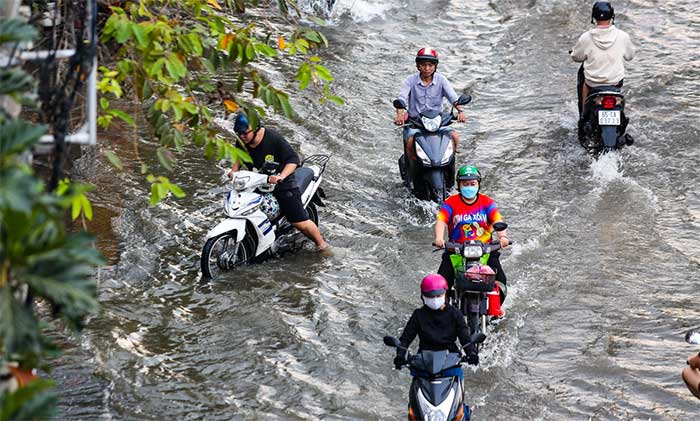A recent study published in the journal Nature Sustainability reveals that Ho Chi Minh City (HCMC) is among the top 5 fastest-sinking cities in the world.
Climate change has led to alarming phenomena globally in recent years, including land subsidence and rising sea levels, according to an article from Tempo on November 21.
The recent study by Nature Sustainability on subsidence rates in various cities shows that HCMC is indeed one of the five fastest-sinking cities worldwide.
1. Tianjin, China
Tianjin has experienced subsidence since the 1920s, with particularly severe cases occurring in the 1930s, primarily due to groundwater extraction.
By the 1960s, some areas of this city had sunk by over 1 meter. The rapid urbanization in China at the end of the 20th century and the beginning of the 21st century has exacerbated the subsidence issue. Roads and skyscrapers built on developing urban areas are major contributing factors.
2. Ho Chi Minh City, Vietnam

Severe flooding in Ho Chi Minh City due to high tide – (Photo: PHUONG QUYEN).
As of May 2024, the Ho Chi Minh City Department of Construction reported that the total subsiding area in the city has reached nearly 7,200 hectares. Areas near rivers and canals are particularly hard hit, with subsidence occurring at a faster rate.
The subsidence rate in HCMC is between 10-15mm per year, with some locations experiencing up to 6-8cm per year. This issue has led to increased flooding occurrences in the city.
Meanwhile, a recent report from the Ho Chi Minh City Department of Natural Resources and Environment indicates that land subsidence in HCMC began to emerge in 1990.
A survey by the Japan International Cooperation Agency (JICA) shows that the subsidence rate in HCMC is about 2-5cm per year. In commercial areas, it is even higher, at 7-8cm per year. This rate of subsidence is twice that of the rising sea level, which is approximately 1cm per year.
From 2004 to 2014, the subsidence rate in HCMC was 10cm over 10 years, with some areas experiencing more. The affected areas include Binh Chanh District, southern Binh Tan District, District 8, western District 7, northwest of the old District 2, eastern District 12, southwestern old Thu Duc District, and northwest Nha Be District. The total subsiding area is 239 km2.
As of 2019, across Ho Chi Minh City, the area of rapid subsidence (over 15mm per year) was 14,775 hectares, the area of relatively fast subsidence (10-15mm per year) was 22,331 hectares, and the area of moderate subsidence (5-10mm per year) was 29,560 hectares.
3. Chittagong, Bangladesh
Chittagong in Bangladesh is one of the fastest-sinking cities in Asia. The area experiences subsidence rates nearly 10 times faster than rising sea levels, measuring 20mm per year from 2015 to 2020.
The demand for groundwater extraction for industrial use and salinity intrusion are serious issues facing the residents of Chittagong.
4. Yangon, Myanmar
Yangon faces increasing challenges with a subsidence rate of 31mm per year. Many experts believe that excessive groundwater extraction is the main cause, leading to the risk of significant earthquakes.
5. Jakarta, Indonesia
Rising sea levels have begun to “submerge” several coastal cities in Indonesia, including Jakarta. The city is sinking at a rate of 26mm per year. This concerning phenomenon has prompted the government to decide to “relocate” the capital from Jakarta to East Kalimantan province.


















































